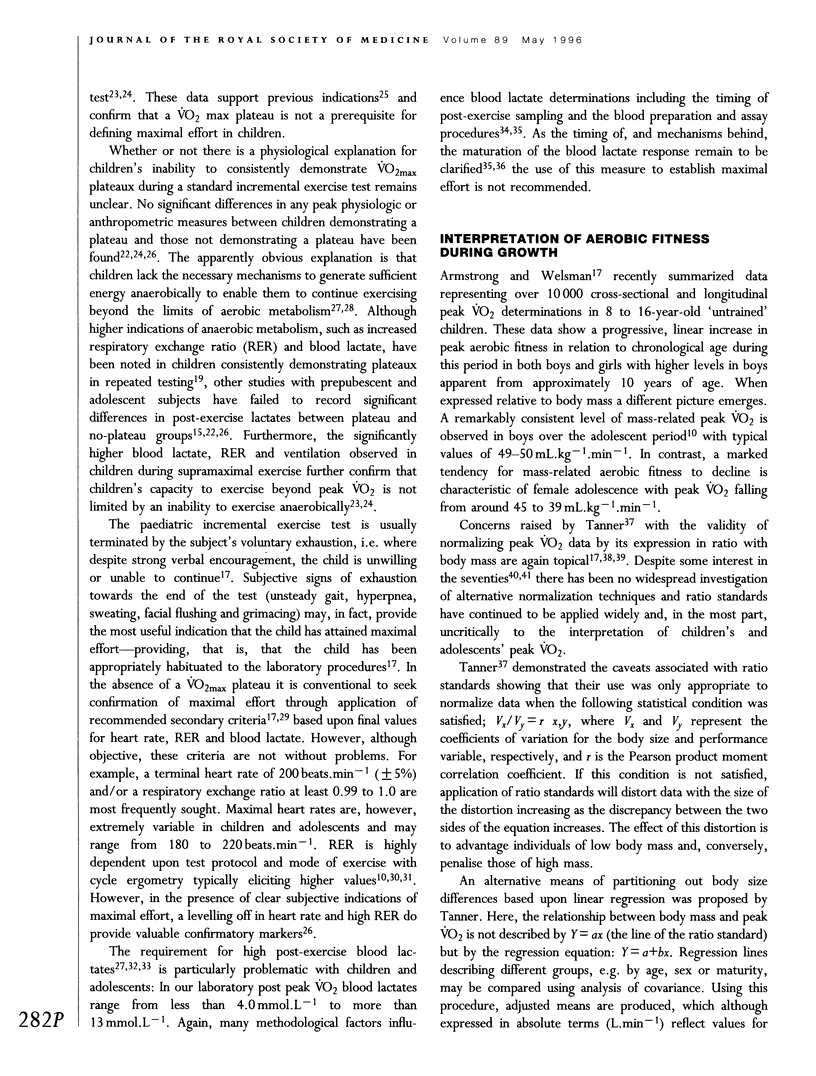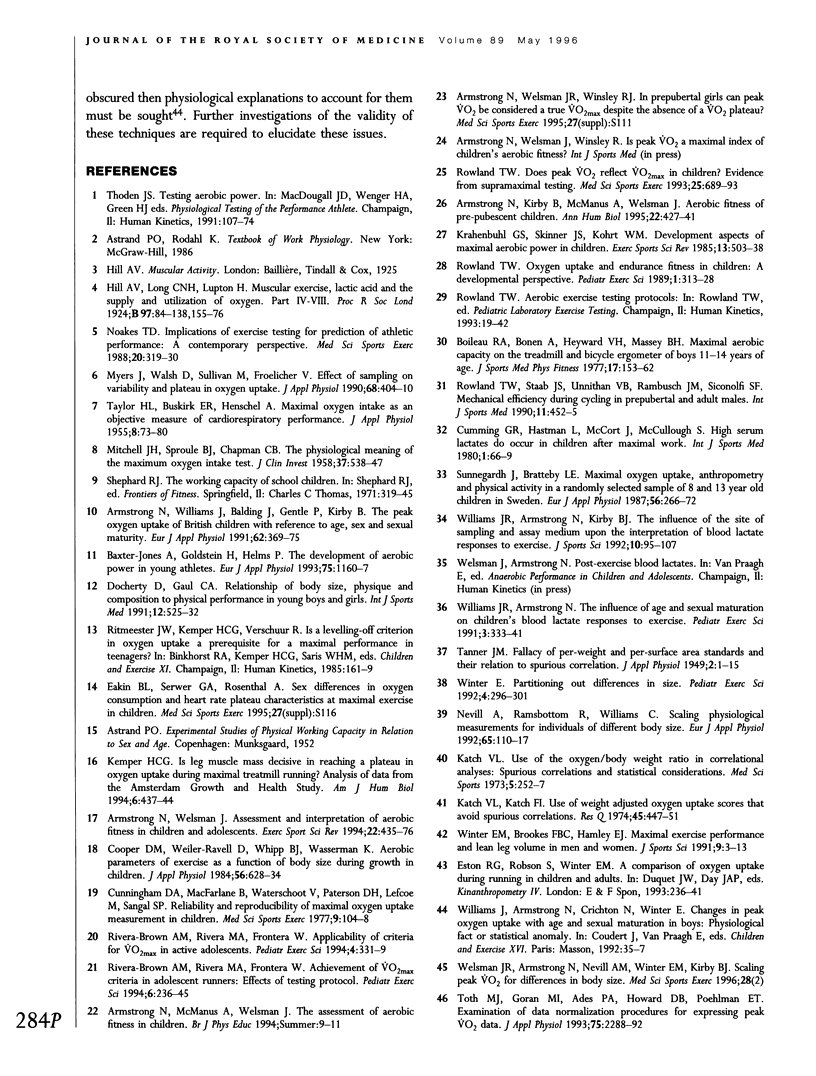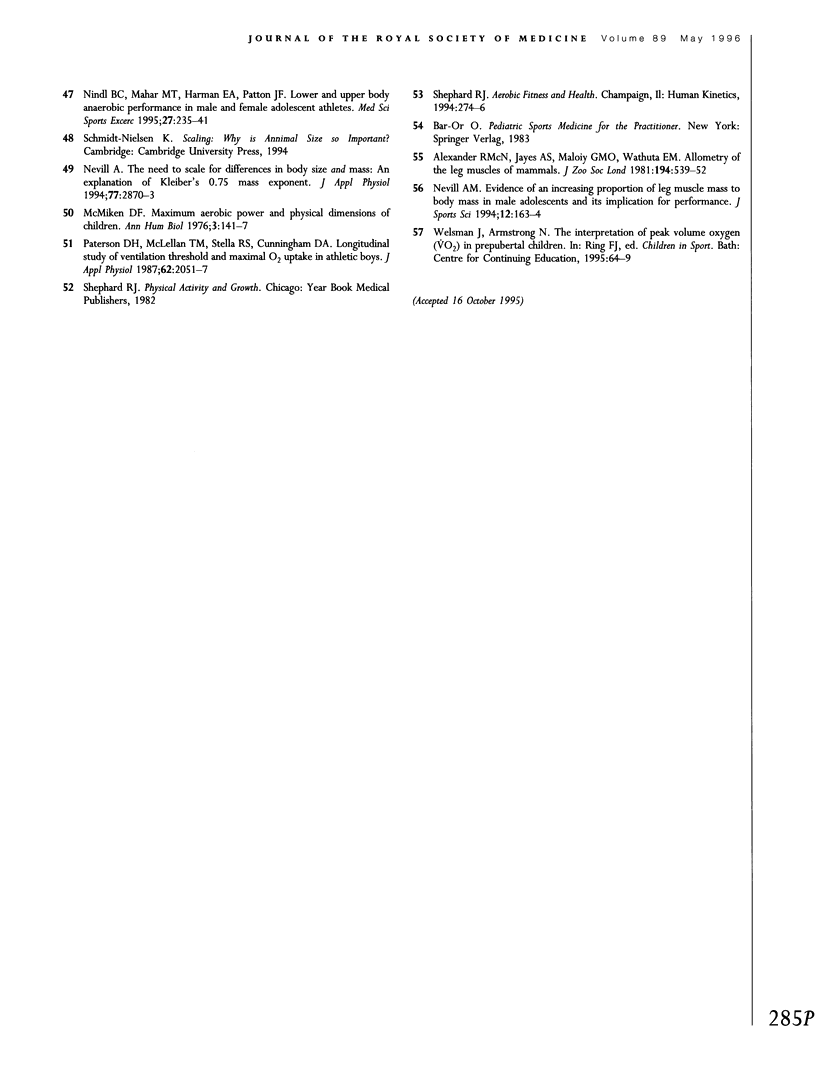Full text
PDF




Selected References
These references are in PubMed. This may not be the complete list of references from this article.
- 42nd Meeting of the American College of Sports Medicine. Minneapolis, Minnesota, May 31-June 3, 1995. Abstracts. Med Sci Sports Exerc. 1995 May;27(5 Suppl):S1–250. [PubMed] [Google Scholar]
- Armstrong N., Kirby B. J., McManus A. M., Welsman J. R. Aerobic fitness of prepubescent children. Ann Hum Biol. 1995 Sep-Oct;22(5):427–441. doi: 10.1080/03014469500004102. [DOI] [PubMed] [Google Scholar]
- Armstrong N., Welsman J. R. Assessment and interpretation of aerobic fitness in children and adolescents. Exerc Sport Sci Rev. 1994;22:435–476. [PubMed] [Google Scholar]
- Armstrong N., Williams J., Balding J., Gentle P., Kirby B. The peak oxygen uptake of British children with reference to age, sex and sexual maturity. Eur J Appl Physiol Occup Physiol. 1991;62(5):369–375. doi: 10.1007/BF00634975. [DOI] [PubMed] [Google Scholar]
- Baxter-Jones A., Goldstein H., Helms P. The development of aerobic power in young athletes. J Appl Physiol (1985) 1993 Sep;75(3):1160–1167. doi: 10.1152/jappl.1993.75.3.1160. [DOI] [PubMed] [Google Scholar]
- Boileau R. A., Bonen A., Heyward V. H., Massey B. H. Maximal aerobic capacity on the treadmill and bicycle ergometer of boys 11-14 years of age. J Sports Med Phys Fitness. 1977 Jun;17(2):153–162. [PubMed] [Google Scholar]
- Cooper D. M., Weiler-Ravell D., Whipp B. J., Wasserman K. Aerobic parameters of exercise as a function of body size during growth in children. J Appl Physiol Respir Environ Exerc Physiol. 1984 Mar;56(3):628–634. doi: 10.1152/jappl.1984.56.3.628. [DOI] [PubMed] [Google Scholar]
- Cunningham D. A., van Waterschoot B. M., Paterson D. H., Lefcoe M., Sangal S. P. Reliability and reproducibility of maximal oxygen uptake measurement in children. Med Sci Sports. 1977 Summer;9(2):104–108. [PubMed] [Google Scholar]
- Docherty D., Gaul C. A. Relationship of body size, physique, and composition to physical performance in young boys and girls. Int J Sports Med. 1991 Dec;12(6):525–532. doi: 10.1055/s-2007-1024728. [DOI] [PubMed] [Google Scholar]
- Krahenbuhl G. S., Skinner J. S., Kohrt W. M. Developmental aspects of maximal aerobic power in children. Exerc Sport Sci Rev. 1985;13:503–538. [PubMed] [Google Scholar]
- MITCHELL J. H., SPROULE B. J., CHAPMAN C. B. The physiological meaning of the maximal oxygen intake test. J Clin Invest. 1958 Apr;37(4):538–547. doi: 10.1172/JCI103636. [DOI] [PMC free article] [PubMed] [Google Scholar]
- McMiken D. F. Maximum aerobic power and physical dimensions of children. Ann Hum Biol. 1976 Mar;3(2):141–147. doi: 10.1080/03014467600001251. [DOI] [PubMed] [Google Scholar]
- Myers J., Walsh D., Sullivan M., Froelicher V. Effect of sampling on variability and plateau in oxygen uptake. J Appl Physiol (1985) 1990 Jan;68(1):404–410. doi: 10.1152/jappl.1990.68.1.404. [DOI] [PubMed] [Google Scholar]
- Nevill A. M., Ramsbottom R., Williams C. Scaling physiological measurements for individuals of different body size. Eur J Appl Physiol Occup Physiol. 1992;65(2):110–117. doi: 10.1007/BF00705066. [DOI] [PubMed] [Google Scholar]
- Nevill A. M. The need to scale for differences in body size and mass: an explanation of Kleiber's 0.75 mass exponent. J Appl Physiol (1985) 1994 Dec;77(6):2870–2873. doi: 10.1152/jappl.1994.77.6.2870. [DOI] [PubMed] [Google Scholar]
- Nindl B. C., Mahar M. T., Harman E. A., Patton J. F. Lower and upper body anaerobic performance in male and female adolescent athletes. Med Sci Sports Exerc. 1995 Feb;27(2):235–241. [PubMed] [Google Scholar]
- Noakes T. D. Implications of exercise testing for prediction of athletic performance: a contemporary perspective. Med Sci Sports Exerc. 1988 Aug;20(4):319–330. doi: 10.1249/00005768-198808000-00001. [DOI] [PubMed] [Google Scholar]
- Paterson D. H., McLellan T. M., Stella R. S., Cunningham D. A. Longitudinal study of ventilation threshold and maximal O2 uptake in athletic boys. J Appl Physiol (1985) 1987 May;62(5):2051–2057. doi: 10.1152/jappl.1987.62.5.2051. [DOI] [PubMed] [Google Scholar]
- Rowland T. W. Does peak VO2 reflect VO2max in children?: evidence from supramaximal testing. Med Sci Sports Exerc. 1993 Jun;25(6):689–693. [PubMed] [Google Scholar]
- Rowland T. W., Staab J. S., Unnithan V. B., Rambusch J. M., Siconolfi S. F. Mechanical efficiency during cycling in prepubertal and adult males. Int J Sports Med. 1990 Dec;11(6):452–455. doi: 10.1055/s-2007-1024836. [DOI] [PubMed] [Google Scholar]
- Sunnegårdh J., Bratteby L. E. Maximal oxygen uptake, anthropometry and physical activity in a randomly selected sample of 8 and 13 year old children in Sweden. Eur J Appl Physiol Occup Physiol. 1987;56(3):266–272. doi: 10.1007/BF00690891. [DOI] [PubMed] [Google Scholar]
- TAYLOR H. L., BUSKIRK E., HENSCHEL A. Maximal oxygen intake as an objective measure of cardio-respiratory performance. J Appl Physiol. 1955 Jul;8(1):73–80. doi: 10.1152/jappl.1955.8.1.73. [DOI] [PubMed] [Google Scholar]
- Toth M. J., Goran M. I., Ades P. A., Howard D. B., Poehlman E. T. Examination of data normalization procedures for expressing peak VO2 data. J Appl Physiol (1985) 1993 Nov;75(5):2288–2292. doi: 10.1152/jappl.1993.75.5.2288. [DOI] [PubMed] [Google Scholar]
- Williams J. R., Armstrong N., Kirby B. J. The influence of the site of sampling and assay medium upon the measurement and interpretation of blood lactate responses to exercise. J Sports Sci. 1992 Apr;10(2):95–107. doi: 10.1080/02640419208729912. [DOI] [PubMed] [Google Scholar]


